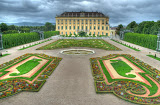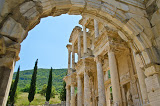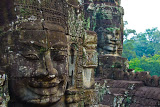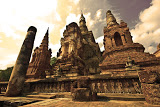384a.jpg?imgmax=1280)
|
|
384a.jpg?imgmax=1280)
|
384a.jpg?imgmax=1280)
|
Kumbakonam Adi Kumbeswara and Upiliappan temple interior
"What should we see in Kumbakonam?" I asked my cousin, as we planned our family excursion through South India. There would be 13 of us traveling, ranging in age from my 94-year-old grandfather to Amara, our not yet 1 year old, packed in a mini-bus to see the best of Puducherry, Kumbakonam, and Tanjore in one week.
"Temples, of course," he responded. Kumbakonam is a town of temples so his answer was no surprise. Almost 200 temples are packed into this 25 square mile town at the intersection of the Kaveri and Arasalar Rivers, deep in Tamil Nadu, the most southern portion of India.
Detailing on the gopuram of the Adi Kumbeswara Temple
My cousin reeled off the names of temples, each with both historical and religious significance. But, there was one I found in my Internet research that he never mentioned. "What about Airavatesvara Temple?" I said, stumbling over the long word.
"I don't know it," he responded. He paused for a second and said, "It must not be very important. It is named for Indra's white elephant --- the steed that carried the Lord of the Devas." My grandmother whose earliest childhood memories are swimming in the Kaveri River and going to school in Kumbakonam, didn't know the Airavatesvara Temple. No one in my extended family --- most of whom visit South Indian temples on their holidays --- had heard of Airavatesvara, either.
But, I insisted that we go and visit. It was listed as an UNESCO World Heritage Site and the Wikipedia page made it sound interesting and, after all, it was only a few miles away from our hotel.
384a.jpg?imgmax=1280)
|
384a.jpg?imgmax=1280)
|
Elephant blessing at the Adi Kumbeswara Temple
We reached Airavatesvara after a long day visiting temples, temples, and more temples, each blending into the other. Amara was tired and annoyed and both Patrick and I were pretty unimpressed by that point.
There's a difference, you see, between visiting temples for their religious value and visiting, as we did, for purely the aesthetic and archaeological interest.
Airavateswara Temple sunset
My extended family is religious in a way that I will never be. It's something that I think comes with growing up in India whereas growing up in the United States. Religion in India is not optional. There is no delineation between church (or temple) and state. Religion is integral and integrated into every part of every day life in India.
384a.jpg?imgmax=1280)
|
|
384a.jpg?imgmax=1280)
|
384a.jpg?imgmax=1280)
|
384a.jpg?imgmax=1280)
|
384a.jpg?imgmax=1280)
|
Tanjore Brihadisvara Temple
In Chennai, we woke in the morning to the sound of bells clanging at the temple. Our auto rickshaw drivers had small pictures of Vishnu, Lakshmi, or Shiva on their dashboards. Every store has a small shrine in it, as does every home have a puja or prayer room set aside. My extended family avoids garlic and onions on certain days of the week and avoids meat altogether. Muslims are equally devout at their mosques as are the Christians at their churches. It is a country where religion pervades every moment of every day.
And, Indians are passionate about their temples. At the busier and more important temples, such as the Tanjore Brihadisvara Temple, the packed crowds suffocate me. One of my earliest memories of India is a frantic devotee pushing my seven year old self to the ground inside the Mysore Chamundi Temple so that she could get a closer glimpse of the Goddess. Even now, as an adult, though I use my elbows to mark my own space, the press of unwashed, undeodoranted people in the stifling interiors nauseates me. And for what? The crowds come together for a momentary glimpse of a tiny statue or figure in semi-darkness.
384a.jpg?imgmax=1280)
|
384a.jpg?imgmax=1280)
|
384a.jpg?imgmax=1280)
|
384a.jpg?imgmax=1280)
|
Patrick and Amara at the Tanjore Temple
Devoutness to the point of fanaticism does not appeal to me, which is perhaps why I have never truly appreciated the large South Indian temples. I can admire the gopuram, the intricately carved exterior pillar at the top of the temple, and the exterior painting. But, in most temples, the interior has been built on the original structure, over and over again, so that the ancient beauty of the temple is lost in expansions of cement and ceramic tile. Others are rarely cleaned, leaving grease marks at the bottom of my feet as I walk through their interiors.
384a.jpg?imgmax=1280)
|
384a.jpg?imgmax=1280)
|
384a.jpg?imgmax=1280)
|
384a.jpg?imgmax=1280)
|
Airavatesvara Temple
But, then, we arrived at the Airavatesvara Temple. It flew in the face of everything I've ever known --- or thought I've known --- about South Indian temples. It was built in the 12th century by the powerful Chola empire, who ruled much of present day India and many of the surrounding islands from their headquarters in present day Tamil Nadu. The Chola empire might hold the record for the longest dynasty in history: this family ruled southern India for almost 1,500 years, beginning in the 3rd century BCE until the late 13th century AD.
The Cholas believed in building, trading, and the proliferation of art and music. Much of the Hindu art and belief in Southeast Asia, including the adoption of the Ramayana by the Thai, was due to the efforts of traders, artisans, and teachers during the Chola empire. But, empires crumble and temples disappear.
Airavatesvara gopuram
There are three --- only three --- of the great Chola temples still standing and without remodel, reconstruction, or alteration since the days of the Chola kings. The three temples have been listed together as the "Great Living Chola Temples" as a UNESCO World Heritage Site, and include the Tanjore Brihadisvara Temple, the Airavatesvara Temple, and the temple at Gangaikondacholapuram (yes, that's a mouthful) near the Ganges River. (This has a great list of the Chola temples found in Bangalore though all of these temples have been renovated, refurbished, or repainted, so it is difficult to differentiate what was original versus modern.)
The steps at the Airavatesvara Temple
The Airavatesvara Temple is the smallest and least important of the three. Legend has it that a sage cursed Airavata, the white elephant who was steed to the king of the gods, turning Airavata black and mottled. Airavata bathed in the sacred waters here and prayed to Lord Shiva, who turned the elephant's skin white again. Unlike the Brihadiswara Temple which was built to celebrate the Chola Empire's communion with Lord Shiva, the Airawatesvata Temple was meant to relate to the populace.
384a.jpg?imgmax=1280)
|
384a.jpg?imgmax=1280)
|
384a.jpg?imgmax=1280)
|
384a.jpg?imgmax=1280)
|
Airavatesvara Temple Pillars
We climbed up the staircase written in ancient Tamil script, flanked by carved elephants and horse-drawn chariots on each side, with the elephant's trunk acting as the bannister. We stood in a hall of pillars, each pillar carved with scenes of daily life at the time of the Chola Empire. One pillar showed crowds of people arriving, throwing flowers, and dancing near the king sitting on a bull. Many of the figures on the stone are no bigger than my thumbnail and the priest inside acts also as our guide, pointing out the intricate details in the temple. He was clearly proud of this strange, small temple.
Bull and elephant in one figure at Airavatesvara Temple
And, rightly so. We walked outside and soon fell into conversation with one of Tamil Nadu's archaeological experts, who has been spending a significant amount of time excavating and analyzing the grounds near the temple. He showed us this beautiful spot where, from one angle, the figure looks like a bull, reaching his head above another animal, and from the other angle, looks like an elephant laying her head on her baby's back, with her trunk spread out before her.
Airavatesvara Temple back
We exclaimed in delight and he showed us more of the temple's features, eager to share his discoveries with others. Once, he complained slightly under his breath that nobody sees these things.
I got that. In the hour we spent there, we had the place to ourselves. Once, we saw a tour group of Westerners who dashed in and out of this place, checking it off their list of India's World Heritage Sites. There were no devotees pushing, shoving, or clamoring to see the God. This place was quiet and empty, a rarity (impossibility?) in bustling India, and waiting since the days of the Chola kings for people to appreciate it.
Details
The Great Living Chola Temples are located around the cities of Kumbakonam and Tanjore (also known as Tanjavur), about 275 kilometers south of Chennai. Most go directly to see the Brihadisvara Temple in Tanjore which is, admittedly, gorgeous and immense. But, I think that the Airavatesvara Temple should not be missed, especially for the lover of arts, architecture, and antiquities.
We stayed at Paradise Resort in Kumbakonam which is a cute hotel geared toward tourists and tour groups. Guests can take a traditional bullock cart (or the much faster golf cart) to get to and from their rooms and there are onsite artisans who produce certain goods, as well as a menagerie of farm animals. While the rooms were nice, the reason I would recommend this hotel is for the food. If you want to try authentic home cooked Tamil fare, this is a great place to get your fill. Their lunchtime thalis were especially good. Every single person in my group --- most of whom are very critical when it comes to South Indian food --- liked the food here.





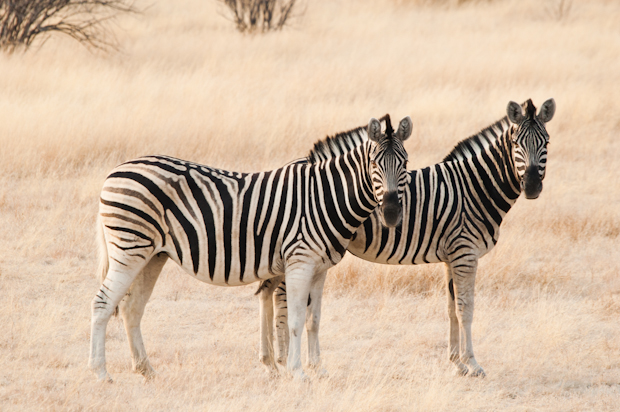


384a.jpg?imgmax=1280)
384a.jpg?imgmax=1280)
384a.jpg?imgmax=1280)
384a.jpg?imgmax=1280)
384a.jpg?imgmax=1280)
384a.jpg?imgmax=1280)
384a.jpg?imgmax=1280)
384a.jpg?imgmax=1280)
384a.jpg?imgmax=1280)
384a.jpg?imgmax=1280)
384a.jpg?imgmax=1280)
